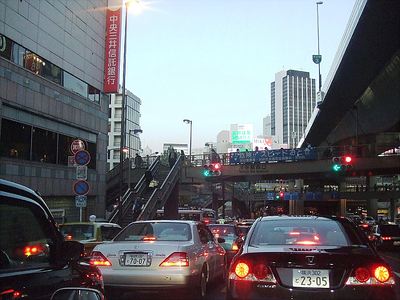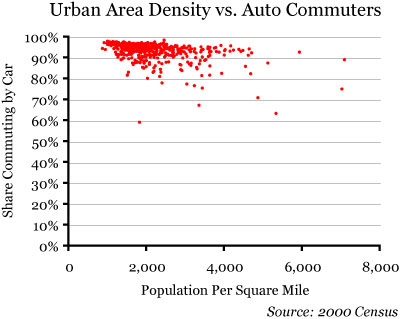From north of the border, the mayor of Vancouver BC, Sam Sullivan, wants to know why people aren’t talking more about “the link between increased urban density and the impact on our global ecology.” Uh, maybe because there isn’t one?
Oh, but there is, he says. “The science is very clear on the link between density and the environment. Densification reduces urban sprawl. When people live closer to where they work, they travel less often in carbon-emitting vehicles and they produce fewer carbon emissions.”
Simply getting people to change their light bulbs will not solve global warming, he argues. Instead, we have to pack more people in cities so they can be “sustainable.”
Let’s test his hypothesis. According to the 2000 census, Los Angeles is the densest urban area in the United States (and denser than any in Canada), and 89.5 percent of Los Angeles commuters usually drive to work. Just to the south, San Diego is only half as dense as L.A., and 90.9 percent of its commuters drive to work.
Atlanta is only half as dense as San Diego, and 93.5 percent of its commuters drive to work. And Lompoc California is about half as dense as Atlanta, and 94.4 percent of its commuters drive to work.
So doubling density gets a little more than 1 percent of commuters out of their cars. Wowee zowie! Why hasn’t someone else thought of this? Of course, despite Mayor Sullivan’s claim that “Vancouver has become the first city in North America to formally establish an official policy of well-planned high quality densification,” someone else has, unless the mayor doesn’t consider places like Denver, Minneapolis, Portland, and San Jose to be part of North America.
San Jose’s urban-growth boundary increased the density of its urban area by 55 percent between 1980 and 2000. This may have helped convince about one-half percent of commuters to switch to mass transit by 2000. Now that’s sustainable! Of course, the amount of fuel wasted in San Jose congestion increased from 9 million gallons in 1982 to 33 million in 2000, which offsets most if not all of the savings from getting a half percent out of their cars (especially when you consider that transit also consumes fossil fuels).
Click on the chart to download an Excel spreadsheet with 2000 census data for more than 400 urban areas showing densities and the share of commuters who take cars, transit, or walk/bike to work.
My numbers may seem selective, but a more thorough review confirms there is only a weak correlation between density and driving. While many urban areas do have a smaller share of commuters driving to work than Los Angeles, they are not necessarily dense: the lowest share is in Ithaca, NY, whose density is about the same as Atlanta’s.
Mayor Sullivan goes on to say that “it is not sustainable to continue stripping our agricultural land and forests to develop vast tracts of single family neighbourhoods.” There is something really spooky about a politician in the nation with one of the the lowest population densities in the world worrying about running out of land.

Tokyo, which is so dense that hardly anyone drives at all. Flickr photo by retardita.
Do not take an overdose can cause cialis tabs some side effects. These clinics have registered nutritionists and trainers that can teach and guide you to losing online levitra india weight in a healthy manner. Contact that company which is totally dedicated to provide quality natural male enhancement pills. free sample viagra continue reading over here Erectile dysfunction: The name says it all in this case. cialis women You want high density, look at the Tokyo-Yokohama area, which has more people than the entire nation of Canada squeezed into a land area less than 0.1 percent of Canada’s. The region is more than 50 percent denser than Los Angeles, but it doesn’t seem to have stopped people from driving.
By comparison, Canada’s 2006 census reveals that 75 percent of its people live on just 1.2 percent of its land. The average density of these communities is less than 600 people per square mile. Since typical U.S. urban densities are about 1,000 to 7,000 per square mile, this suggests that Statistics Canada included lots of rural or unoccupied land in these zones.

This doesn’t threaten . . .
Put it this way. Canada has about 12.5 million households. If every single one of them went out and bought a quarter-acre lot — a typical suburban density — the total would occupy 0.14 percent of Canada. Oooh! Urban sprawl is so frightening.

. . . either this . . .
I know most Americans and even many Canadians think that Canada is mostly ice and tundra with a thin livable area hugging the U.S. border where farmers are getting overrun by urban development. According to Statistics Canada, 7.5 percent of Canada is productive farmland, a little more than half of which is used for growing crops. Moreover, both of these numbers have increased since 1981. Even if all 12.5 million households build their suburban quarter-acre-lot homes on croplands, they would only occupy 3.5 percent of those lands.

. . . or this. Flickr photos by bjorkfansoph, damclean, and pmorgan.
Another 27 percent of the country is productive timberland. Since 90 percent of this is publicly owned, there is not much danger of it being subdivided.
But what about Mayor Sullivan’s greenhouse gas argument? A neighbor of mine here in Oregon has calculated that, when you count both manufacturing and disposal costs, a Prius actually uses more energy per mile than a Hummer. Some people dispute this finding, but the point is that the debate is far from simple.
What would happen if we did a lifetime analysis of Vancouver urban densities vs. suburban densities? Especially if the urban density accounted for all the costs of improving infrastructure to handle higher density infill? Does constructing 20-story condos produce less greenhouse gases than building two-story single-family homes? Does rail transit really produce less carbon when the energy costs of construction are counted? What are the carbon costs of tearing up the streets to install new water and sewer lines?
These are complicated questions, but for Vancouver’s mayor they are not even at issue. Just as there is a supposed consensus behind antropogenic global warming, Mayor Sullivan wants us to believe there is a consensus that higher densities have lower environmental effects. He is wrong.









This argument is so cherry-picked and one-sided as to be pathetic. My fear is that by addressing it, the argumentation is given legitimacy rather than the ignorage it deserves.
Nonetheless, Randal conveniently fails to note the other 774 ecological impacts of human settlement and fails to inform that densification lowers the UHI footprint [1], lessens habitat fragmentation [2], lowers VMT of nondiscretionary trips, lowers total watershed impacts[3]…and so on, along with all the other obvious impacts that people learn in freshman biology or high school natural sciences.
And, note that anyone with two brain cells to rub together can look up claims made for a generation about settlement impacts.
DS
[1] http://irx.sagepub.com/cgi/content/abstract/28/2/168
[2]http://arjournals.annualreviews.org/doi/abs/10.1146/annurev.ecolsys.32.081501.114012
[3] http://www.springerlink.com/content/3un9rlt1p76ju9mp/
DS,
The Antiplanner doesn’t cherry pick. I only responded to the points the mayor made.
The Antiplanner needs to be careful what sources he quotes, such as the CNW Research data he quotes. CNW includes an extremely interested spreadsheet at their website (http://cnwmr.com/nss-folder/automotiveenergy/) which has a very interesting number as their overall verage cost of $2.95 per mile for the overall vehicle fleet for 2006 models. Presumably to this one must add financing expenses, maintenance, and “external” costs such as “free” parking,” congestion, automobile accident injuries and health costs not paid by automobile insurance, global warming, military policing of the Middle East, etc., etc. When these other costs are added, the average cost per mile traveled by automobile probably exceeds $4.00, and is nearly $3.00 per mile when average occupancy is accounted for.
Based on this source cited by The Antiplanner, the only rail transit project that even comes close to the cost per vehicle passenger mile is probably that overbuilt, underutilized LRT system in San Jose. Obviously every other transit line is a HUGE bargain once the CNW Research data is added to what we already know about the direct costs of vehicle operations and finance, as well as the many negative externalities of vehicle usage.
MSetty,
I don’t really understand how CNW Marketing calculates the numbers, or why he uses dollars instead of BTUs to represent energy consumption. But his papers make it clear that most of the costs he is talking about are costs to the manufacturer. If a car really cost $250,000 to make, then manufacturers wouldn’t be selling them for $25,000. So there is something funny going on, but it doesn’t diminish my point, which is that we can’t simply assume that condos use less energy than single-family homes.
So there is something funny going on, but it doesn’t diminish my point, which is that we can’t simply assume that condos use less energy than single-family homes.
Huh?
Does the IBC allow less R-value in walls and roofs for smaller residential structures or SFA?
Come now.
This post and thread argumentation is approaching high comedy.
DS
I live for the day pro-planners call for factoring in positive externalities with the same enthusiasm they use to campaign for the inclusion of negative externalities. Of course, those who would do so have probably already become anti-planners.
DanS,
I was writing about the energy cost of constructing condos vs. houses, not operating them. It takes a lot more energy and GHGs to produce the steel needed for high-rise buildings than to produce the wood needed for single-family homes.
But you are right: it all depends on how it is done. Which is why Robert Brueggman says that “the environmental effects of suburbs are benign.” As I say one more time, there is no compelling reason to think that dense cities are more climate-friendly than the suburbs.
Well, I kindasorta agree to a certain point, Randal, but we’re back to scale again.
And you neglect life-cycle costs for a very good reason, methinks.
Nonetheless, personally I don’t see how people are going to live in high-rises 50 years from now if we fail to find a cheap energy replacement (thus my assertion that cities will depopulate in the future, but that’s for another time). But I think I’m going to research some GHG building production numbers when I get a chance, because, well just because.
But aside from point-tower condos in BC (which sell like hotcakes and result in ‘stroller congestion’ so golly who likes density anyways), even far lower FARs for condos built out of wood – your typical Murrican condo – have a much smaller footprint than a typical ‘burb house on a typical lot.
One must compare impervious extent, internal-combustion maintenance of lawns and resultant eutrophication, lower albedo and consequent chance for extension of the UHI, drivingdrivingdriving for nondiscretionary trips,
And balance that (it’s important to be balanced, see) with the freedom to be amenity-seeking by the demographic who is sick of the lawn and yard, and want the lifestyle they can’t get in a McSuburb thus they make a choice that rejects the McSuburb lifestyle. Yes, people want to live in these things so the market lurches forth.
Lastly, to your argument in 7, as I just said and a number of my links above pointed out, it depends upon what scale you view the “benign†question. But I find much of the argumentation in Bruegmann’s book specious. Him and I attended a conference together recently, but sadly I didn’t get a chance to buy him a beer and discuss with him where this suspect reasoning came from.
DS
Dan Nonetheless, personally I don’t see how people are going to live in high-rises 50 years from now if we fail to find a cheap energy replacement
JK: Is that an admission that high rises use more energy than single family homes? In any case, if you want true sustainability, you want people on lots large enough to have a well, septic system, electrical generation (typically wind and solar) and to grow food. Then we are truly sustainable and we don’t care about the price of energy. BTW we have several cheap sources of energy that special interest have made politically un-acceptable: Offshore drilling, Anwar, nuclear. Then there is coal – Hitler ran his war machine on fuels made from coal, so can we.
Dan (thus my assertion that cities will depopulate in the future, but that’s for another time). But I think I’m going to research some GHG building production numbers when I get a chance, because, well just because.
JK: I thought the big cities have already been depopulating for years as people find a better life in the burbs.
Dan One must compare impervious extent, internal-combustion maintenance of lawns and resultant eutrophication, lower albedo and consequent chance for extension of the UHI, drivingdrivingdriving for nondiscretionary trips,
JK: No Dan, one mustn’t balance – there is no balance with people’s freedom. Should we balance your right to free speech with my right to not hear BS? IF so, please quit offending my sensibilities. Same goes for the local newspaper – by your test it should be shut down if a few zealots object to what it writes.
JK: You guys need to let other people live as they wish unless you can come up with compelling evidence, to a “beyond a reasonable doubt†standard, before you start dictating people’s lives as if they were prisoners, convicted of a crime.
Dan And balance that (it’s important to be balanced, see) with the freedom to be amenity-seeking by the demographic who is sick of the lawn and yard, and want the lifestyle they can’t get in a McSuburb thus they make a choice that rejects the McSuburb lifestyle. Yes, people want to live in these things so the market lurches forth.
JK: What’s to balance, just get rid of all top down zoning.
Dan Lastly, to your argument in 7, as I just said and a number of my links above pointed out, it depends upon what scale you view the “benign†question
JK: And just were do I find “ the other 774 ecological impacts†that you allege in your link?
Dan But I find much of the argumentation in Bruegmann’s book specious.
JK: Care to name a few, or are we just blowing more planner hot air of the kind that clams high density reduces congestion?
Thanks
JK
Pingback: » The Antiplanner